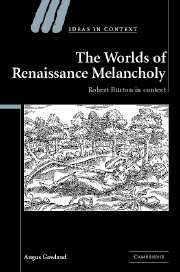Book contents
Introduction
Published online by Cambridge University Press: 13 January 2010
Summary
Surveying the world outside his study in Christ Church, Oxford, at the end of the year 1620, Robert Burton diagnosed an epidemic of melancholy. It was now, he thought, ‘a disease so frequent … in these our daies, so often happening … in our miserable times, as few there are that feele not the smart of it’. Since it was ‘a disease so grievous, so common’, he claimed to ‘know not wherein to do a more generall service, and spend my time better, then to prescribe means how to prevent and cure so universall a malady, an Epidemicall disease, that so often, so much crucifies the body and minde’ (1.110.9–19). Burton cited a range of neoteric philosophical and medical authorities to support his diagnosis. Whilst examining the spleen and its role in generating hypochondriacal melancholy in the 1552 edition of his De anima, Philipp Melanchthon had written that there were so many cases of this disease it was pointless to count the sufferers. Later in the century André du Laurens had concluded his chapter on the same species of melancholy by noting its frequency ‘in these miserable times’, and pointing out that ‘there are not many people which feele not some smatch thereof’. ‘This disease is most frequent in these days’, agreed Girolamo Mercuriale, in the chapter on melancholy in his Medicina practica of 1601.
- Type
- Chapter
- Information
- The Worlds of Renaissance MelancholyRobert Burton in Context, pp. 1 - 32Publisher: Cambridge University PressPrint publication year: 2006
- 1
- Cited by



